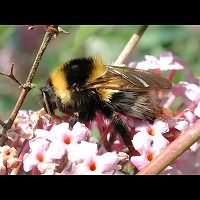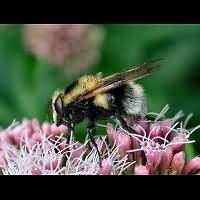Garden Bumblebee Bombus hortorum
More striking than the previous species is the Garden Bumblebee. This is a big species. Take the queen for instance. She can be up to 22 mm long, reaching a wingspan of some 4 cm! Workers and drones usually range from 13 to 16 mm, reaching a wingspan of some 3 cm. The animal looks a lot like the Earth Bumblebees, but it always has a white tail and two yellow bands on the thorax: one on the frond and another one on the rear. Some bumblebees fly in February, weather conditions allowing, the Garden Bumblebee takes it time. The first specimens are usually not seen before mid-March. But in our region this is one of the very few bumblebees capable of producing a second generation regularly. That's why it can often be seen until the first part of October. The Three-banded White Tail Bumblebee feels at home near humans. It is ready to nest almost everywhere. The nest can be somewhere in the earth, for instance in old mice nests, but nesting opportunities high above, such as old birds nests, nesting boxes, attics etc. will also be gladly accepted. Even though the animal will visit an enormous variety of flowers it is known to be fond of thistle and clover. There are only a few species of bumblebees being able to reach the clover's nectar, for this is produced deep inside the flower. Some other species, including the Common Carder Bee, being short-tongued, can not reach the goodies. They use other and more drastic measure to get what they want: they'll bite a hole in the flower near the nectar source. For a long time people appreciated the Long-tongued Bumblebee being the best pollinator around for beans. In the past it was scientifically known as Megabombus hortorum, because of the long tongue. The nests typically contain some 50 to 120 individuals. This species is very common all over Europe, including all of the British Isles.
In the top picture is a drone, the male Garden Bumblebee. In the middle picture is a queen. The bottom picture is an animal looking like the Garden Bumblebee. It is not a bumblebee though, but a hoverfly: Volucella bombylans plumata. Flies can not sting and have little means of defending themselves. That is why many species imitate dangerous insects, capable of stinging, such as wasps and bees.
The Garden Bumblebee is also known as the Long-tongued Bumblebee and the Three-banded White-tail Bumblebee.
More striking than the previous species is the Garden Bumblebee. This is a big species. Take the queen for instance. She can be up to 22 mm long, reaching a wingspan of some 4 cm! Workers and drones usually range from 13 to 16 mm, reaching a wingspan of some 3 cm. The animal looks a lot like the Earth Bumblebees, but it always has a white tail and two yellow bands on the thorax: one on the frond and another one on the rear. Some bumblebees fly in February, weather conditions allowing, the Garden Bumblebee takes it time. The first specimens are usually not seen before mid-March. But in our region this is one of the very few bumblebees capable of producing a second generation regularly. That's why it can often be seen until the first part of October. The Three-banded White Tail Bumblebee feels at home near humans. It is ready to nest almost everywhere. The nest can be somewhere in the earth, for instance in old mice nests, but nesting opportunities high above, such as old birds nests, nesting boxes, attics etc. will also be gladly accepted. Even though the animal will visit an enormous variety of flowers it is known to be fond of thistle and clover. There are only a few species of bumblebees being able to reach the clover's nectar, for this is produced deep inside the flower. Some other species, including the Common Carder Bee, being short-tongued, can not reach the goodies. They use other and more drastic measure to get what they want: they'll bite a hole in the flower near the nectar source. For a long time people appreciated the Long-tongued Bumblebee being the best pollinator around for beans. In the past it was scientifically known as Megabombus hortorum, because of the long tongue. The nests typically contain some 50 to 120 individuals. This species is very common all over Europe, including all of the British Isles.
In the top picture is a drone, the male Garden Bumblebee. In the middle picture is a queen. The bottom picture is an animal looking like the Garden Bumblebee. It is not a bumblebee though, but a hoverfly: Volucella bombylans plumata. Flies can not sting and have little means of defending themselves. That is why many species imitate dangerous insects, capable of stinging, such as wasps and bees.
The Garden Bumblebee is also known as the Long-tongued Bumblebee and the Three-banded White-tail Bumblebee.






